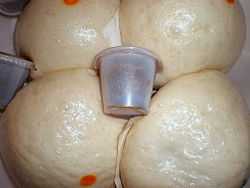Siopao
From Wikipedia, the free encyclopedia
| Siopao | |
|---|---|
| Baozi | |
 Siopao buns from the Philippines with dipping sauce | |
| Alternative name(s): | |
| Salapao (Thailand) | |
| Place of origin: | |
| Philippines, Thailand | |
| Recipes at Wikibooks: | |
|
| |
| Media at Wikimedia Commons: | |
|
|

A street vendor in Chiang Mai, Thailand, selling various types of salapao
Siopao (Chinese: 燒包; Pe̍h-ōe-jī: sio-pau) is a Hokkien term for bāozi (包子), literally meaning "steamed buns".[1] It has also been incorporated into Thai cuisine where it is called salapao (Thai: ซาลาเปา).[2]
A popular food item in the Philippines and Thailand, siopao and salapao do not require utensils to eat and can be consumed on-the-go. Like bāozi, there are different varieties based on stuffing: Asado or bola-bola (which may use pork, chicken, beef, shrimp or salted duck eggs).[3] There is also a baked variety.[4]
See also
- Bāozi, the Chinese version of the steamed bun.
- Mandarin roll
- Mantı
- Mántóu
- Nikuman
- Bánh bao
- List of buns
-
 Food portal
Food portal
References
- ↑ Frances Lorraine Haw-Ang (August 25, 2010). "Top 10 Siopao in Manila". http://www.spot.ph. Retrieved 21 December 2010.
- ↑ "Salapao – Chinese Steamed Buns". http://www.thaizer.com/. January 15, 2010. Retrieved 21 December 2010.
- ↑ Robert Colinares (September 30, 2008). "Siopao (Steam Buns)". http://www.filipino-food-lovers.com. Retrieved 21 December 2010.
- ↑ http://www.mixingbowl.com/content/GELACIOSFILIPINOAMERICANRECIPES/recipe/5805221/Baked-Siopao
| ||||||||||||||||||||||||||||||||||||||||||||||||||||||||||
| |||||||||||||||||||||||
This article is issued from Wikipedia. The text is available under the Creative Commons Attribution/Share Alike; additional terms may apply for the media files.